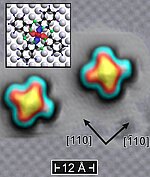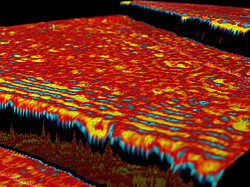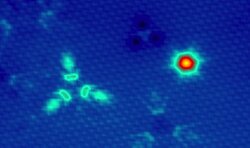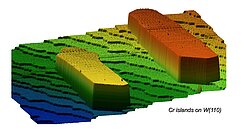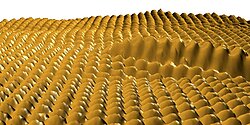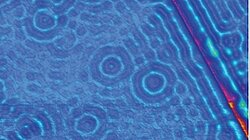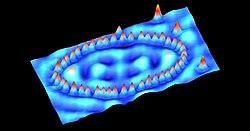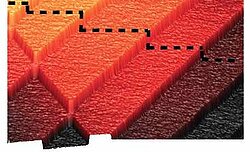pre 2014
Image & Results Gallery (pre 2014)
MnPc molecules on Ag(001)
The image on the right shows a part of the results which were achieved in cooperation with theorists from Würzburg's ITPA in which we have studied the Kondo properties of MnPc on Ag(001) by means of low-temperature scanning tunneling spectroscopy. Our results highlight the importance of hybridization and filling of the molecular orbital for the development of a Kondo resonance.
The result has been published in Nano Letters.
Click image for full size view.
Rashba-split surface states on a lead-silver alloys
Rendered 3-dimensional representation of the surface of a PbAg surface alloy. Two mono-atomic step edges can be recognized. The surface is color-coded by using the simultaneously measured differential conductance. Standing waves that result from interfering electron waves can be recognized as alternating yellow/blue stripes in the central part of the image.
Click image for full size view.
Quasi-particle interference mapping of topological insulators
Scanning tunneling microscopy is not only capable of imaging the landscape of a surface (topography). In addition, spectroscopic modes also allow to obtain a wealth of information on various electronic properties. For example, by analyzing Fourier-transformed maps of the differential conductance one can study the energy dispersion relations and scattering channels. The image to the right shows measurements performed on the topological insulator Bi2Te3.
Click image for full size view.
Click here for publication.
Chromium islands on W(110)
This false color image shows the landscape of a W(110) surface after depositing some chromium (Cr). Similar to water on a glass pane the Cr prefers to stick together and form some kind of "drops" on the surface. But, owing to the interaction with the substrtae, the shape of the Cr drops is quite different from conventional water drops. They exhibit an elongated, slightly hexagonal shape and their top surface is flat.
Click image for full size.
Click here for publication.
Herringbone reconstruction of Au(111)
Bulk gold (Au) exhibits a face-center cubic (fcc) crystal structure. However, the Au(111) surface is unstable against reconstruction as the surface free energy can be lowered by periodically adding atoms. Thereby, the stacking of the surface Au layer relative to the first subsurface layer periodically oscillates between fcc and hexagonal close-packed (hcp). The image the tight shows this so-called "herringbone reconstruction".
Click image for full size view.
Atomic resolution on Au(111)
Electron interference in Ag(111)
Electrons occupying surface states of noble metals form a 2D free electron gas. This can be probed by STM by looking at the quantum mechanical interference of the electrons wave functions scattered by potential, i.e. steps or defects. By analyzing these oscillation it is possible to obtain constant energy cuts and band dispersion.
Click image for more details.
Quantum corral
Quantum corrals are nanoscale structures formed by positioning individual atoms into ring like shapes on a substrate. In this image, 43 Co atoms where positioned on the Ag(111) surface. The cobalt atoms reflect the surface electrons of the Ag(111) inside the ring into a wave pattern. As predicted by the theory of quantum mechanics, the size and shape of the corral determine its quantum states, including the energy and distribution of the electrons. Consequently, these object can be used to control the spatial and spectral distribution of surface electrons.
Click image for full size view.
See the movie here.





